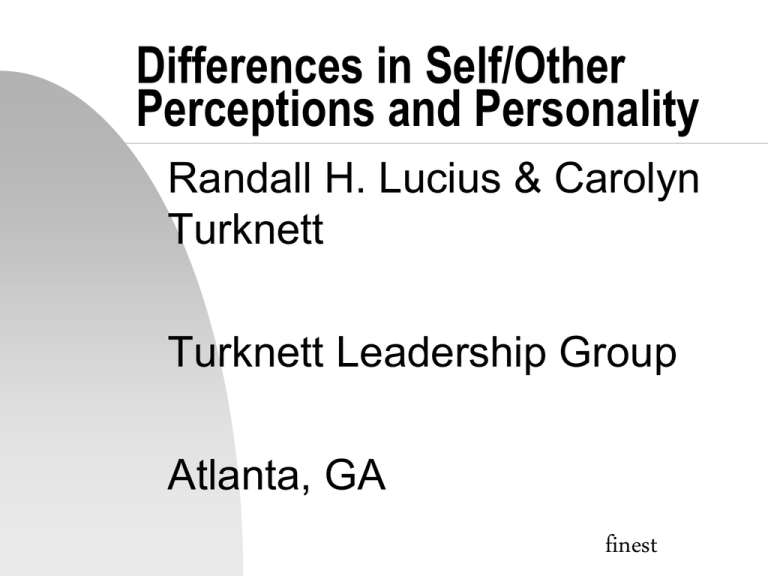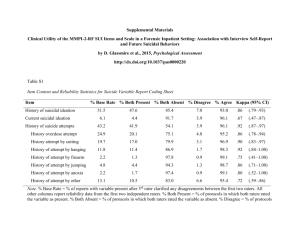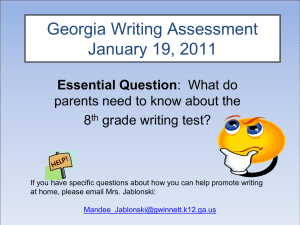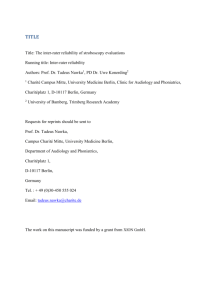Differences in Self/Other Perceptions and Personality
advertisement

Differences in Self/Other Perceptions and Personality Randall H. Lucius & Carolyn Turknett Turknett Leadership Group Atlanta, GA finest Abstract 2 Personality differences between those who rated themselves higher than how others perceive them (over raters) and those who rated themselves lower than how others perceive them (under raters) on a 360 leadership instrument were studied. Results found that over raters are more extroverted than under raters, while under raters are more anxious than over raters finest Introduction 3 Most studies of self/other differences in 360 assessments argue over accuracy vs. value of variation from multiple raters What about individual differences in self/other difference scores? This study explored personality differences associated with those who over or under rate themselves. finest Introduction (cont.) Past Findings: MBTI: IS’s have most accurate self perception (Roush & Atwater, 1992) Self-Esteem: those low in selfesteem less likely to over-rate (Baird, 1977) Those high in Intelligence, nAch, internal locus of control are more accurate (Mabe & West, 1982). Gender differences equivocal. 4 finest Introduction (cont.) Importance Accurate self-perceivers make better decisions (Bass & Yammarino, 1991) Inaccurate self-perceivers more likely to deny problems, give up, and fear failure (Wohlers & London, 1989) Moderates leader performance (Atwater & Yammarino, 1992) Can strain CEO/TMT relationship and affect strategy (Ashford, 1989) 5 finest Method Subjects: 186 executives who participated in the Turknett Executive Development Program. 25% female Age range: 37 to 55; Avg=44 360 instrument: Coworker Rating Scale (Hagberg, 1984). measures 47 different behaviors 6 E.g. decisiveness, thoroughness, forthrightness, consideration, adaptable, self-confidence, motivating others, empowerment finest Method (cont.) Personality: Jackson Personality Inventory (Jackson, 1994) & Personality Research Form (Jackson, 1989). Difference score computation: co-worker 7 ratings (superior, peer, subordinate) were averaged together by item and subtracted from self score. An average difference score across items was computed finest Method (cont.) Difference score computation (cont.): Two groups were formed: those who tend to overrate themselves and those who underrate. 8 Differences between over and under raters on the JPI and PRF were assessed via t-tests. finest Results 7 out of 35 possible relationships emerged from the specific scales 1 of 7 factors also emerged Personality Variable Anxiety Breadth of Interests Risk Taking Sociability Social Confidence Affiliation Exhibition Play JPI/PRF Factor 1: Extroversion 9 Mean LSR Differences > 0 (N=74) 7.62 13.07 13.18 10.50 15.85 9.90 9.92 7.64 .21 Mean LSR Differences < 0 (N=112) 9.11 11.71 11.02 8.49 13.83 8.70 7.94 6.72 -.20 2-Tail Sig. finest .02 .02 .00 .00 .00 .03 .00 .04 .00 Results (cont.) Under raters suffer from a higher amount of anxiety than those who over rate themselves Over raters scored high on traits related to extroversion Risk Taking, Sociability, Social Confidence, Play 10 Over raters also have greater breadth of interests finest Discussion Those who are socially confident and extroverted tend to have inflated images of themselves. Extroverts are more “action” oriented than “deep thinking” oriented Extroverts are less introspective than Introverts may lead to inaccurate self perception 11 finest Discussion (cont.) Those with a large breadth of interests also tend to over rate. Is related to Extroversion, but also Openness to Experiences Those who are anxious may undervalue themselves. Similar findings have been found with individuals low in self-esteem (Baird, 1977; Farh and Dobbins, 1989) 12 finest Discussion (cont.) Knowledge of one’s personality can help practitioners know what to expect. E.g. for someone who is extroverted, the practitioner can expect them to have inflated images of themselves and prepare 360 feedback accordingly to “soften the blow” 13 finest Discussion (cont.) Extroverts may need more selfawareness training Highlights importance of using both 360 and personality measures Introverts may under value themselves and their abilities The issue for these people may not be their deficiencies as identified in a 360, but rather self confidence. 14 finest Discussion (cont.) 15 Under estimator’s anxiety may also tie in to lack of confidence and regard for self. While humility is often valued as a positive leadership trait, too much may have negative consequences. finest Implications for Future Research Discussion points need to be more carefully examined before any firm conclusions can be made More sophisticated methodology should be explored. E.g. Other correlates with over/under rating oneself should be explored E.g. 16 Polynomial regression job performance finest











